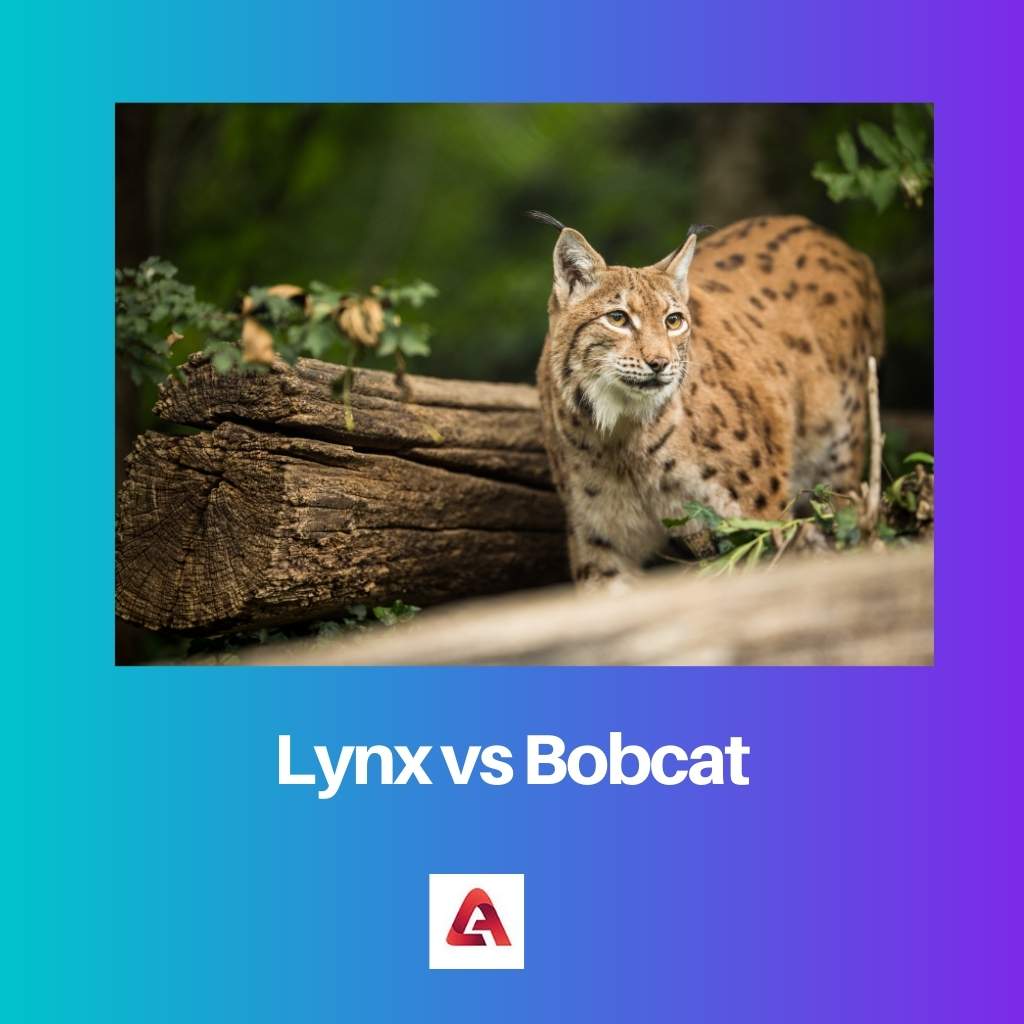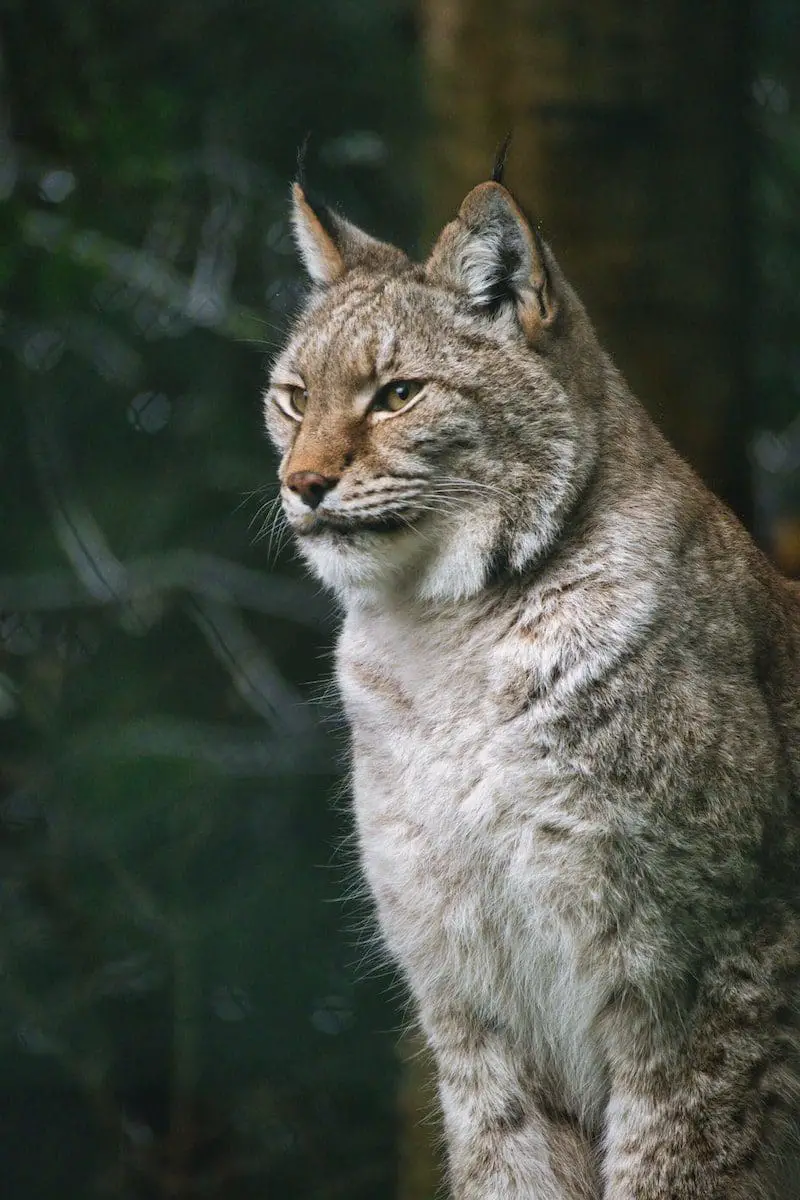The earth is the only planet that has the existence of life on it. 30% of the landmass and 70% of the oceans and seas contains different life forms in which, some of which have been explored, and some are still unknown.
The experts have found many similar species belonging to the same genus of plants and animals. Such an example is different types of cats like – Lynx and Bobcats.
Key Takeaways
- Lynx and bobcats are both medium-sized wild cats found in North America.
- Lynx have tufted ears and shorter tails than bobcats.
- Lynx are larger than bobcats and are found in colder regions, while bobcats are found in various habitats.
Lynx vs Bobcat
Lynx is smaller in size compared to the Bobcat. Lynx has larger feet and longer legs compared to the Bobcat. While the Bobcat’s tail is banded with black stripes and is black at the top of the tip and white at the bottom, the Lynx’s tail lacks banding and is all black at the tip.

Lynx is the genus of the cat, with four other species belonging to it. The scientific name of the Canada Lynx is Lynx canadensis. The cat measures up to a length of approximately 31-51 inches. The nature of the cat is very gentle and calm. They weigh up to 29 kg and are quite heavy.
Bobcat also belongs to the same genus that is Lynx but is different in species. The scientific name of the cat is Lynx Rufus. The second common name used for the cat is Red Lynx. According to the IUCN Red List, they have listed Bobcat is the least concerned because of their high population and distribution.
Comparison Table
| Parameters of Comparison | Lynx | Bobcat |
|---|---|---|
| Ears | Long tuft | Short tuft |
| Tail | Short tail with banding and tip is entirely black | Long-tail with no banding and the tip of the tail is black with white underneath |
| Color | Grey with indistinct spotting on the skin | Reddish-brown colour with distinct spotting |
| Size of legs | Legs are long, and the ones present at the back are longer than the front legs. | Legs are shorter, and the back legs are slightly longer than that of the front legs. |
| Size of Cat | Large | Small |
| Feet | They are large and have big paws with fur underneath, and the back leg paws are large. | They have short paws, and the paws present at the back are short in size |
| Disposition | Gentle in nature | Aggressive in nature |
| Diet | Prefer snowshoe hare | They have a lot differ prey varieties |
| Weight | Around 8-29 kg | Around 5-17 kg |
| Geographical Range | Canada, Spain, Europe, Asia | United States of America, Mexico, Southern Canada |
| Habitat | Mountains, Forests, Steppes | Desert, swamps, woodland |
What is a Lynx?
Lynx is a genus of cats that is to be found in the geographical range or area of Canada, Spain, Asia, and Europe. The natural habitat region of the cats is the mountains, forests, and steppes.
The size of the cat may reach up to 31-51 inches, and weighs up to 29 kg, thus can be considered heavier. The tail of the cat was short and had a tip of black color.
The hind legs of the cat are longer and are distinct from the forelegs. The hind paws of the cat are even large with fur beneath it. The nature of the cat is gentle and calm.
The ears are large with dense hairs on them. The diet or food eaten by the Lynx cat is – ducks, grouse, vole, red squirrels, snowshoe hares, etc. In the IUCN Red List, they have been listed as the least concerned species besides the illegal hunting of cats for their fur.
The genus has four further species, and that are – Canada Lynx, Iberian Lynx, Eurasian Lynx, and the Bobcat. The Lynx cat has very bright and luminescent eyes that glow in the dark. Also, they have very long whiskers on their face.

What is a Bobcat?
Bobcat is one of the groups that lie in the category of genus Lynx. The original scientific name of the cat is Lynx rufus. The geographical arena of the cat is that it belongs to southern Canada, Mexico, and America.
The other name of the cat is the Red Lynx. The natural habitat of the cats is the swampy area, deserts, woodlands, etc. The size of the cat ranges from up to 41 inches and weighs around 17 kg; thus, it is lighter. The hind leg of the cat is not as distinctively larger as the Lynx cat.
The paws are even shorter, and the ear tuft is triangular and with dense hair. The nature of the cat is said to be quite aggressive. Although the cat is being hunted down extensively because of its fur and for sport, it has still been categorized as the least concerned species by the IUCN Red List.
The diet or food of the cat is primarily hares and rabbits, but sometimes it may also hunt down – insects, geese, rodents, deer, and small animals. The lifespan of the cat is 7 years and can be extended up to 10 years, although the maximum life span reported for the bobcat is 16 years.

Main Differences Between a Lynx and a Bobcat
- The size of the ear tuft of the Lynx cat is large, whereas comparatively, on the other hand, the size of the ear tuft Bobcat is small in size.
- The tail of the Lynx is short with an entire black tip; it also has to band on it, whereas comparatively, on the other hand, the tail of the Bobcat is large with no banding over it and also has a black tip with the presence of white color underneath it.
- The color of the Lynx cat is slightly grey with some indistinct spotting over the skin, whereas comparatively, on the other hand, the color of the Bobcat is reddish-brown with distinct spotting over the skin.
- The size of the legs is long, and the legs present at the backside are distinctly larger than that present at the front side for Lynx cats while comparatively, on the other side, the size of the legs is shorter, and the legs present at the back are not distinctly large than the front in the Bobcat.
- The size of the Lynx cat is large, whereas comparatively, on the other hand, the size of the Bobcat is small.
- The feet of the Lynx cat are large, the paws have fur underneath, and the paws of the legs present at the back are even large, whereas comparatively, on the other side, the feet of the Bobcat are small along with the paws present at the backside.
- The nature of the lynx cat is very gentle, whereas comparatively, on the other side, the nature of the Bobcat is very aggressive.
- Lynx cats prefer snowshoe hares in their diet, while comparatively, on the other hand, Bobcats prefer a variety of animals in their diet.
- The weight of the Lynx cat is around 8-29 kg; thus, they are heavier, while comparatively, on the other side, Bobcat weighs around 5-17 kg and thus is lighter.
- Lynx cats are can be found in Canada, Spain, Europe, and Asia, while comparatively, on the other side, Bobcat is found in Mexico, southern Canada, and America.
- The suitable habitat for the Lynx cat is mountains, forests, and steppes, while comparatively, on the other side, the suitable habitat for the Bobcat is deserts, swamps, and woodland.

- https://royalsocietypublishing.org/doi/full/10.1098/rspb.2013.2495
- https://journals.plos.org/plosone/article?id=10.1371/journal.pone.0051488
- https://bioone.org/journals/the-american-midland-naturalist/volume-173/issue-2/amid-173-02-305-317.1/Diet-of-the-Recovering-Ohio-Bobcat-Lynx-rufus-with-a/10.1674/amid-173-02-305-317.1.short



